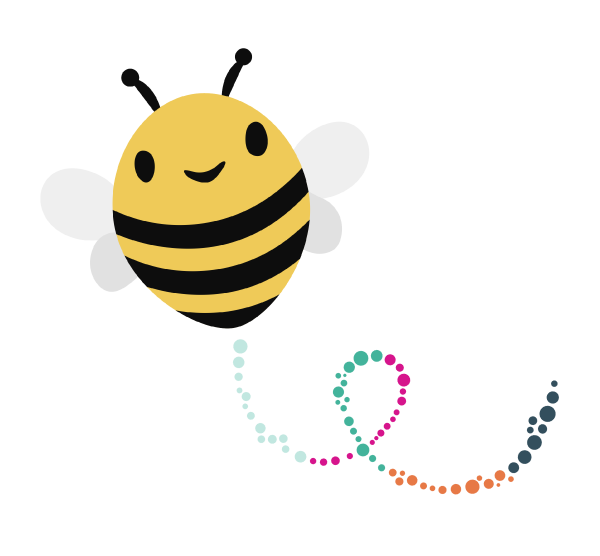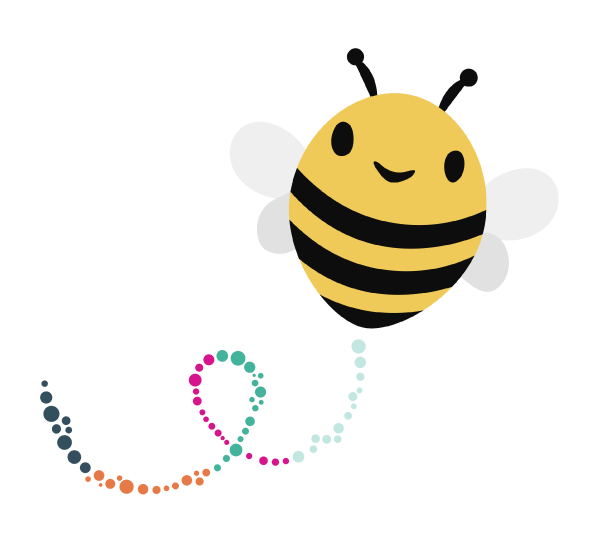Setting up your bee farm kit in 3 easy steps
Gardening has never been so easy!
1
Install the bee house
Choose your location wisely. The bees might have trouble finding it if you decide to move it later. Here is what to look for:
- Plants/flowers: Find a spot within 300 feet of the flowers and plants you want to be pollinated
- Safety: Place it waist-high or higher, where it won’t be knocked over by house pets or ground critters
- Morning sun: The bees love morning sun best (do not face the home west if it will get afternoon sun)
- Dry: Keep your bees away from sprinkler spray and up off the dewy ground
2
Release the Bees
We’ve designed the cocoon box with a wide viewing window so you can enjoy observing your pre-hatched bees before you release them. They will be buzzing and ready to pollinate upon release.
- Mount the bee home: approximately no higher than 4’ off the ground
- Open near the bee home: Now you are ready to place your bees in their new home
- Remove the stickers form the sides of the orange bee box
- Open the lid: tear off the top, there is a perforation at the back of the lid
- Bees will come out: do not be afraid they will want to go feed on your nearby flowers
- Place the open box: This will slide into the loft. You are welcome to place them on the front porch ledge to observe them flying out.
- Remember: leafcutter bees are gentle, kind souls. You do not need to be afraid.
- Enjoy watching your bees get to work pollinating your garden
3
Wait patiently
It’s all about the time and temperature. The warmer the weather, the faster your bees work. If temperatures cool, be prepared for your bees to to slow down their work. Here is what to expect:
- Remember: it can take weeks for your bees to fill the nesting tubes
- Keep checking: the bee home and your plants and flowers for activity
- What to expect: Little cutouts in the leaves of your plants. Bees carrying leaves to the nesting tubes Nesting tubes to start filling with little baby bees.


Get your front row seat to nature in action.
Everything included except the lounge chair.

Arrival Day
Your bee adventure begins! Big smiles and pollen love is coming your way.
- Keep ’em safe. Don’t remove the cocoon box lid until you are ready to put the bees inside their home. Let’s keep them safe from accidental spills.
- Keep ’em close. Put your home somewhere you can watch the bee cuteness. Half-moon leaves and cocoons will be under construction!
- Warm, dry, morning sun. No sprinkler surprises for our fuzzy-belly friends, please!
Bee Meets Flower
Bees are hungry! They go hunting around your flowers looking for food.


Flower Feeds Bee
The nectary in a flower is – you guessed it! – where all the nectar (bee food) is stored. Bees have to dig in the base of your flowers to get to the Nectary.
Bee Gathers Pollen
On the way to the Nectary, they pass the male part of the flower called the Stamen, it’s the part that produces the Pollen. When the bees pass this male part, the Pollen ‘accidentally’ rubs off and sticks to their little bodies. Basically, the Pollen catches a ride on the Bees.


Bee Delivers Pollen
When the Bees go to the next flower, they visit a part of the flower called the Pistel. This is the female organ, and it’s the part of the flower that receives the Pollen. This step is essential to beginning the process of fertilization.
The Love S-P-R-E-A-D-S
One flower isn’t enough! The Bees keep flying around, eating more of the Nectar and getting more of the Pollen on them so it’s constantly being collected and re-distributed around your flowers and plants.

Don’t you love the harmonious way nature works?
Bee Farm Kit FAQs
blank
How many Kind Bee Kits should I buy for my yard?
- Small apartment patio to urban yard: 1 Kind Bee Kit
- Larger suburban yards: 2 Kind Bee Kits
- Yards over 1 acre: 3 Kind Bee Kits
It’s not a science! If you have questions about your space or our pollinator houses for sale, please email us at hello@kindbeefarms.com. Remember, you need flowers and plants for these bees to find food or they might hire a moving van and move your bee home to another yard!
Where in my yard should I place my bee home?
LOCATION
- Within 300 feet of the flowers + plants you want pollinated.
- Somewhere where it cannot be knocked over or threatened by any house pets.
- Once you pick a spot, please try not to move the home or the bees might have trouble finding their new location.
- Height: Keep your home above the waist to prevent moisture and ground critters from bothering the bees.
- You can easily walk over, say hello to your bees, and experience the bee activity. Go ahead, enjoy!
SUN
- Your Kind Bees love morning sun, and do not love direct afternoon sun. Even though your bee home has an overhanging roof to protect the bees from too much direct sun, we recommend you do not face the home west if you put the home in an area that gets afternoon sun.
WATER
- Kind Bees do not like to get wet! Keep your Kind Bees away from sprinkler spray. The design of the home will protect them from natural rainfall.
How long will my bees take to hatch?
It depends on a few factors! Here’s the thing about hatching: it’s all about the time and the temperature. The warmer the cocoons get, the faster they hatch. If they are in a cool temperature – indoors or outdoors- they will take a little longer.
If you start by keeping the cocoon box indoors: expect 1-3 weeks, depending on temperature.
If you start by putting the cocoon box outside: expect 1-6 weeks, depending on temperature.



